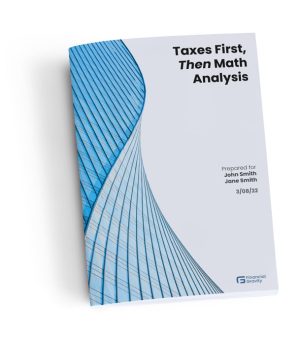Many investors have heard the term asset allocation. Asset allocation is a cornerstone of prudent wealth management, aiming to balance risk and return and dampen volatility. Properly done, asset allocation will incorporate the investor’s investment horizon—how long the investor intends to hold the portfolio—and risk tolerance.
But there is another vitally important factor in portfolio management, particularly among family offices: taxes. Our Taxes First, Then MathⓇ investment philosophy, which dictates that portfolio structure be decided before specific products are chosen, also demands that attention be paid to which types of products should be in which types of accounts.
This specific, tax-forward discipline is known as asset location. Once the ideal mix of financial products is determined (asset allocation), the investment management team considers the client’s financial plan, tax laws, trading interval, and the inherent tax and return profile of the underlying assets, to place each asset in the appropriate account.
When all factors are considered—, the client’s unique situation, the asset allocation, and the account types—, a holistic solution can be achieved. Holistic approaches are common in family offices. We refer to our proprietary process as HALOⓇ, an acronym for holistic asset location optimization.
HALO: Grounded in Market Realities
The HALO concept is grounded in market realities. Stocks, bonds, and cash each have their own characteristics of risk and return and can be expected to behave differently over time. HALO is also grounded in our belief that every client family is unique, both in their need for and tolerance for risk, but also in their saving, spending, and legacy needs.
There are some fundamentals in asset location. For example, growth (non-dividend paying) stocks intended to hold for the long term naturally fit into taxable accounts. Muni bonds also fit neatly into taxable accounts. Bonds and dividend payers make more sense in tax-deferred accounts so that the income streams can compound free of tax until withdrawn, ideally in retirement when tax brackets are often lower.
Individual stocks also offer the flexibility to harvest losses in taxable accounts. If a favored stock that you would otherwise hold onto suffers from a price drop, you can sell that stock and, 31 days later, buy it back again. Those realized losses can then be used to offset gains on other positions. This is a common practice among the high-net-worth cohort, but it offers benefits to just about anyone.
Holistic Performance Evaluation Is Critical
HALO does require investors to have investments in both taxable and tax-deferred accounts. A balanced allocation consisting of stocks and bonds typically gets the most benefit from asset location. However, clients that have 100% stock or 100% bond portfolios can still benefit.
Investors should remember to examine their statements holistically. It’s the overall, total-portfolio risk and return target that matters. There are situations where the risk profile in two different accounts seems wildly different; for example, imagine one account with all stocks and another with bonds and cash. Naturally, the stock account will have much wider swings, and investors must remember that is simply the nature of equity risk. That volatility is the reason for the bond and cash account, which values liquidity and lower volatility, and is designed to forestall the kind of losses that lead to the buy high-sell low trap.
Asset location can have a significant impact on your wealth. Long term capital gains and qualified dividends are taxed at 0%, 15% and 20%, depending on income levels in a given year. Taxable interest and non-qualified dividends are taxed as ordinary income, and those brackets range from 10% to 37.5% at the federal level, and as much as 13.1% in California.
In addition to taxable and tax-deferred (qualified) accounts, there is an after tax account type, the Roth IRA. Often Roth accounts are neglected and underutilized. Even a modestly sized Roth account can be a fantastic place for certain kinds of inherently, but attractive, financial products that offer attractive but tax-inefficient return distributions.
Financial Gravity Family Office Services, the Registered Investment Advisory firm we partner with, conducted a simple impact analysis of HALO and determined that optimized asset location created 11.43% more wealth in a portfolio managed over a 40 year period.
Unlike many things in the world of investment management, asset location is a simple concept to understand. Deferring tax on bond and dividend income so the account can compound faster just makes sense. Combined with loss harvesting and low turnover, HALO can have a profound impact on portfolio returns.
Asset location optimization is automatically applied, at no additional charge, to Financial Gravity Asset Management accounts governed by the same investment policy statement.
Financial Gravity strives to innovate and act in our clients’ best interests, and asset location optimization is just one example.









